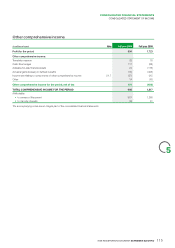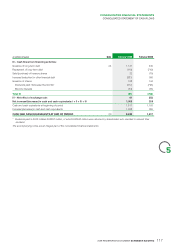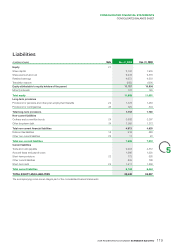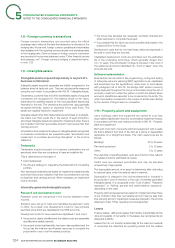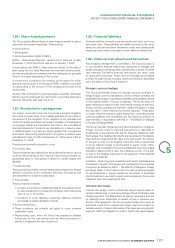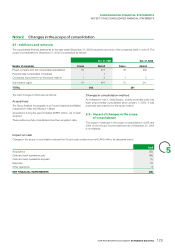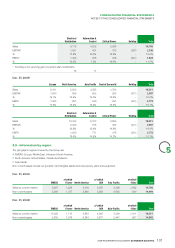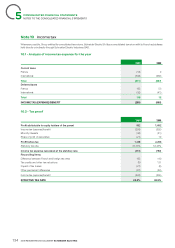APC 2009 Annual Report Download - page 126
Download and view the complete annual report
Please find page 126 of the 2009 APC annual report below. You can navigate through the pages in the report by either clicking on the pages listed below, or by using the keyword search tool below to find specific information within the annual report.
2009 REGISTRATION DOCUMENT SCHNEIDER ELECTRIC124
CONSOLIDATED FINANCIAL STATEMENTS
5NOTES TO THE CONSOLIDATED FINANCIAL STATEMENTS
1.8 - Foreign currency transactions
Foreign currency transactions are recorded using the official
exchange rate in effect at the date the transaction is recorded or the
hedging rate. At year-end, foreign currency payables and receivables
are translated into the reporting currency at year-end exchange rates
or the hedging rate. Gains or losses on foreign currency conversion
are recorded in the income statement under “Other fi nancial income
and expense, net”. Foreign currency hedging is described below,
in note1.23.
1.9 - Intangible assets
Intangible assets acquired separately or as part of a
business combination
Intangible assets acquired separately are initially recognised in the
balance sheet at historical cost. They are subsequently measured
using the cost model, in accordance with IAS38 – Intangible Assets.
Trademarks, customer lists and other identifi able assets of acquired
companies are recognised in the balance sheet at fair value,
determined by qualifi ed experts for the most signifi cant assets and
internally for the rest. The valuations are performed using generally
accepted methods, based on expected future cash fl ows. The
assets are regularly tested for impairment.
Intangible assets other than trademarks are amortised on a straight-
line basis over their useful life or the period of legal protection.
amortised intangible assets are tested for impairment when there is
any indication that their recoverable amount may be less than their
carrying amount.
Amortisation and impairment losses on intangible assets recognised
on business combinations are presented under “amortisation and
impairment of purchase accounting intangibles” in the income
statement.
Trademarks
Trademarks acquired as part of a business combination are not
amortised when they are considered to have an indefi nite life.
This is determined on the basis of:
•brand awareness;
•the Group’s strategy for integrating the trademark into its existing
portfolio.
Non-amortised trademarks are tested for impairment at least annually
and when there is any indication that their recoverable amount may
be less than their carrying amount. When necessary, an impairment
loss is recorded.
Internally-generated intangible assets
Research and development costs
Research costs are recognised in the income statement when
incurred.
Systems were set up to track and capitalise development costs
in 2004. As a result, only development costs for new products
launched since 2004 are capitalised in the IFRS accounts.
Development costs for new projects are capitalised if, and only if:
•the project is clearly identifi ed and the related costs are separately
identifi ed and reliably tracked;
•the project’s technical feasibility has been demonstrated and the
Group has the intention and fi nancial resources to complete the
project and to use or sell the related products;
•the Group has allocated the necessary technical, fi nancial and
other resources to complete the project;
•it is probable that the future economic benefi ts attributable to the
project will fl ow to the Group.
Development costs that do not meet these criteria are expensed in
the year in which they are incurred.
Capitalised development costs are amortised over the estimated
life of the underlying technology, which generally ranges from
3 to 10years. The amortisation charge is included in the cost of
the related products and classifi ed into “Cost of sales” when the
products are sold.
Software implementation
External and internal costs for the programming, coding and testing
of enterprise resource planning (ERP) applications are capitalised
and amortised over the applications’ useful lives. In accordance
with paragraph98 of IAS38, the Bridge SAP system currently
being deployed throughout the Group is amortised using the unit of
production method to refl ect the pattern in which the asset’s future
economic benefi ts are expected to be consumed by the entity. The
units of production correspond to the number of actual users divided
by the number of target users on completion.
1.10 - Property, plant and equipment
Land, buildings, plant and equipment are carried at cost, less
accumulated depreciation and any accumulated impairment losses,
in accordance with the cost model provided for in IAS16 – Property,
plant and equipment.
Each part of an item of property, plant and equipment with a useful
life that is different from that of the item as a whole is depreciated
separately on a straight-line basis. The main useful lives are as
follows:
Buildings: 20 to 40years
Plant and equipment: 3 to 10years
Other: 3 to 12years
The useful life of operating assets, such as production lines, refl ects
the related products’ estimated life cycles.
Useful lives are reviewed periodically and may be adjusted
prospectively if appropriate.
The depreciable amount of an asset is determined after deducting
its residual value, when the residual value is material.
Depreciation is charged to the income statement or included in
the production cost of inventory or the cost of internally-generated
intangible assets. It is recognised under “Cost of sales,” “Research
expenses” or “Selling, general and administrative expenses”,
depending on the case.
Property, plant and equipment are tested for impairment when there
is any indication that their recoverable amount may be less than
their carrying amount. Impairment losses are charged to the income
statement under “Other operating income/(expense)”.
Leases
Finance leases, defi ned as leases that transfer substantially all the
risks and rewards of ownership to the lessee, are recognised as an
asset and a liability.
Leases that do not transfer substantially all the risks and rewards
of ownership are classifi ed as operating leases and the related



